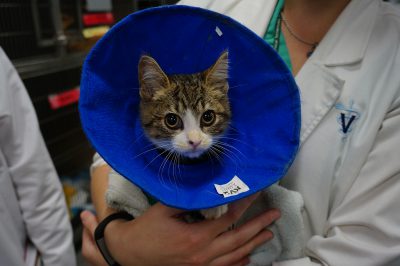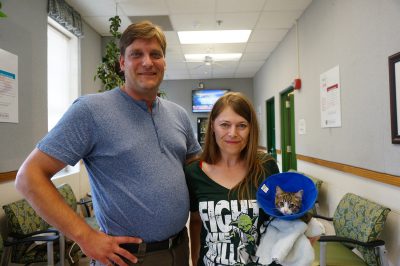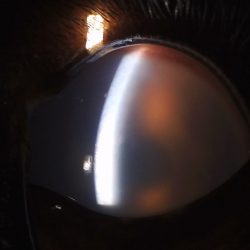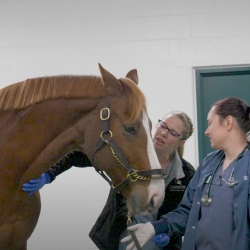History and Diagnosis

Clarke, an intact male kitten approximately two months of age, was presented to the MSU Veterinary Medical Center after being found as a stray three weeks prior. When Clarke’s owners found him, he appeared healthy. His new owners brought Clarke to a primary care veterinarian, who performed a kitten exam and provided deworming, flea medication, and SQ fluids.
After a few days at home, Clarke’s abdomen became distended and his preputial area was swollen. Clarke’s owners took him back to the veterinarian, where a cystocentesis was performed to relieve some distention on the bladder. The veterinarian then referred Clarke to an emergency clinic.
At the emergency clinic, an abdominal ultrasound was performed and Clarke’s bladder was drained via urinary catheter. Clarke was then transferred to a second emergency clinic, where the veterinarian noted bruising in the perianal area. The abdomen had become enlarged, was painful, and unable to be expressed. The second emergency clinic attempted unsuccessfully to place another urinary catheter. A cystourethrogram demonstrated a tear in the urethra. The clinic then placed the urinary catheter surgically, although urine still escaped around the catheter.
After 10 days, the catheter was removed. Clarke urinated normally once, but then became obstructed and was unable to urinate again. Efforts to pass another urinary catheter were unsuccessful. The owners discussed with their veterinarian that Clarke’s condition may not be treatable, and that euthanasia may be the best option. The veterinarian then recommended coming to MSU for one last chance.
Treatment and Outcome

At MSU, Clarke was transferred to Soft Tissue Surgery for a contrast cystourethrogram that showed a stricture, or narrowing of the urethra, preventing normal urination. Based on this information, clinicians made a plan for Clarke to undergo a perineal urethrostomy.
When the area of the stricture was determined to be too far toward the bladder during surgery, the surgeons converted their approach to a prepubic urethrostomy, routing Clarke’s urethra to empty along his abdomen. Clarke was neutered as part of the surgery as well. Sores that were noted on either side of the tail base at presentation were cleaned and allowed to heal naturally. Clarke was sent home with pain medications, antibiotics, and topical cream for the wounds at the base of his tail (Clavamox, buprenorphine, and silver sulfadiazine cream).
Comments
The prepubic urethrostomy allows Clarke to urinate via a stoma on his lower abdomen. Clarke may have experienced some leaking of urine as he relearned how to urinate. The leaking can cause scalding on the inside of his thighs. Clarke may retain some level of incontinence for the rest of his life. He also is at a higher risk of developing a urinary tract infection.
Because he is so young, as Clarke grows, the stoma may or may not grow with him. If the stoma becomes too small, revision surgery may be necessary to widen it.



